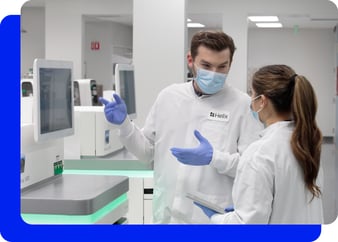
Faced with a need to rapidly scale their laboratory processes to help with pandemic testing, Helix was suddenly aware of how much work they’d need to do to get their legacy LIMS ready for the incoming volume. Tasked with finding a quicker solution, Tyler Cassens, seasoned LIMS expert, turned to his partners at Semaphore and their next-generation laboratory informatics technology, Labbit.
 Company Profile
Company Profile
Helix is a leading population genomics and viral surveillance company empowering individuals to use DNA to improve their health. Their proprietary Sequence Once, Query OftenTM model empowers healthcare organizations and companies to uncover genetic insights more efficiently to improve patient care and public health decision making.
Solution replaced: A highly customized legacy on-premises laboratory information management system (LIMS).
The Situation
Several years ago, Helix managed their complex next-generation sequencing (NGS) laboratory processes with a legacy, on-premises LIMS employing Semaphore Solutions to maintain the system via outsourced LIMS development services as their assays evolved.
When the COVID-19 pandemic hit the United States in 2020, Helix recognized the opportunity to help their local communities and the entire nation open up and get back to work via rapid PCR testing—an opportunity their experience and technology was well suited to.
Their existing LIMS had already shown signs of needing an upgrade to handle the complex processes they were performing. Extensive programming was required to customize it for their comprehensive workflows, and even still, workflows required extra clicks and steps which slowed turnaround time and took their technicians’ focus away from their main tasks.
The addition of PCR testing for coronavirus would test the existing LIMS’ ability to scale. Even with Semaphore’s help reconfiguring workflows, the monolithic infrastructure wasn’t designed to handle the sample volumes required to effectively deliver test results at the pace the nation desperately needed—sometimes as many as 100,000 samples per day.
Around this time, Tyler, was assigned the task of sourcing a LIMS that would more quickly get Helix where they needed to be now and in the future. Across his career at various biotech companies, including Helix, Tyler has tended to gravitate toward LIMS-related projects, giving him extensive experience with the different available options. A six-year veteran of Helix, he also had a deep understanding of their unique requirements.
Among the more well-known LIMS vendors, none were able to address all of his laboratory informatics needs. One was capable of handling NGS workflows, but was lacking in important operational areas such as biobanking and reagent management. And the opposite was the case with another system.
“That’s what stood out when evaluating Labbit. That this LIMS could finally achieve all of our needs within one solution. To be able to not only manage the workflow, but the operational side of things as well.”
It was a priority for him to find a cloud-based solution that would offer greater performance and reliability, and offload the ongoing maintenance requirements of on-premises servers from his IT team.
“We wanted to be cloud-based and be looking ahead for the next decade rather than stuck in a platform that was built ages ago, and behaved like it was built ages ago.”
The Solution: Labbit
Working with Semaphore over the years, the team at Helix had developed a deep trust in their expertise and dedication to the success of their clients. Tyler was aware that Semaphore had developed their own informatics solution—Labbit—a response to the frustrations the Semaphore team and their clients had encountered with LIMS over the years. After learning more, and because of the confidence he had in their partnership, Tyler was convinced that Labbit was what Helix needed to manage their laboratory moving forward.
Requirement #1: Modeling extremely complex workflows
Over the years, Helix had built a highly-customized NGS workflow that incorporated automated liquid handling integration, advanced rework paths, and highly sophisticated optimization algorithms. Modeling these in the old system had taken years worth of custom backend programming.
In contrast, Labbit uses the intuitive nature of business process model and notation (BPMN) technology to specify workflows as seamlessly as drawing on a whiteboard. Using nesting and logic-based routing, intricate processes can be mapped out and translated into Labbit workflows in a relatively short period of time. Helix’s selection of Labbit was reinforced early in the implementation when they were able to quickly model with Labbit BPMN a process that had taken years of programming with the old system.
Requirement #2: Flexibly adapting to evolving requirements
It’s not enough to be able to model a workflow in its current state, a LIMS—a genomics LIMS in particular—must be able to adapt to constantly evolving laboratory processes and environments. Many LIMS have been built with a view that laboratory processes are straightforward, homogeneous, and static, leading to LIMS functionality that is rigid and difficult to modify without programming.
Helix’s business had already gone through two major shifts in focus and it was imperative that their new LIMS could support continued innovation and change.
Labbit has been designed with flexibility in mind, leveraging knowledge graph database technology. Unlike relational databases (which other LIMS are built on) that require laboratories to decide upfront what types of information they want to capture, graph databases and their structure are inherently flexible, ensuring that the data captured by Labbit remains perfectly synchronized to evolving laboratory processes with minimal effort.
Additionally, because it easily integrates with laboratory instruments and other business systems, Tyler was assured that Labbit would seamlessly integrate with Helix’s equipment and applications today and into the future.
Requirement #3: All-in-one laboratory informatics functionality
Labbit had another intriguing feature—it is entity-centric.
This means that anything can be represented as an object in its system. Samples, people, reagents, controls, equipment, even the assays themselves. By coupling this feature with highly flexible workflows, Helix is able to extend the use of Labbit beyond a traditional LIMS to accomplish what previously would have required investment in two or three other systems.
Requirement #4: Streamline and scale operations
Time is money—yes—but if you’re a patient waiting for a diagnosis it can also literally mean life or death. With their post-pandemic focus shifting back to clinical diagnostics and pharmacogenomics, Helix needed to increase performance and turnaround times with new technologies.
Labbit’s highly configurable platform helps Helix increase efficiency at the bench by automating many of the distracting, tedious procedures that the old system required. Labbit can handle complex workflows in parallel at scale. Plus, with Labbit deployed in the cloud, Helix benefits from performance and reliability as well as an IT team that no longer has to devote their valuable time to maintenance of an on-premises system.
“Moving into physician ordered testing, there’s more of an onus on turnaround time as a result. Knowing there’s a patient waiting on it. It becomes crucial to be able to move a sample through a workflow and still achieve high accuracy. Labbit allows us to process all these different complex workflows in parallel and do it at scale which has been a challenge with other platforms.”
The Results
The world has come out of the pandemic and the demand for high volume COVID-19 PCR testing has dropped dramatically. Although Helix continues to sequence and track new cases across the United States to understand dominant and novel strains of the virus, they have returned their focus to population genomics while expanding into diagnostics and pharmacogenomics. With the support of Labbit, this pivot has been relatively seamless and they’re confident that they can get new or changed assays online quickly moving forward.
“As we look ahead to the future, we’re always going to be asking how quickly can we iterate? How quickly can we release updates to a workflow, or create brand new workflows. Labbit is a huge piece of that puzzle and how quickly it will allow us to test, validate and get new workflows into production.”
Also with Labbit, performance has improved drastically at the bench, removing friction and allowing technicians to focus on what matters most.
“Right now the performance is what stands out the most to the end user. You’re able to process samples through the workflow in a fraction of the time compared to other systems. From logging in to completing a workbook, every click matters when you are processing tens of thousands of samples within a given shift. Labbit simplifies everything for the operator allowing them to turn their focus where it belongs: on their bench work. They interact with the instrument which communicates with Labbit, seamlessly progressing samples behind the scene. Tasks that previously took 20 minutes can now be completed in under 5.”
Conclusion
Armed with Labbit’s completely reimagined LIMS—plus solution and their trusted partnership with Semaphore, Tyler and the rest of the team at Helix feel confident that they can continue to innovate and grow at a pace that their science dictates, not their LIMS.



